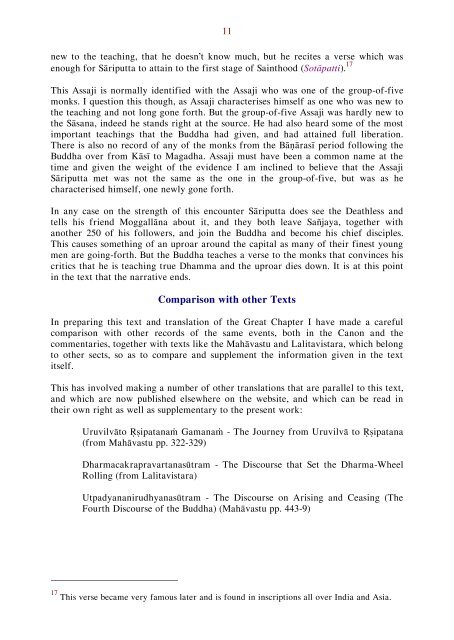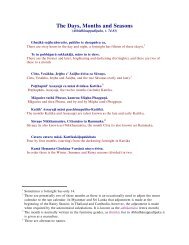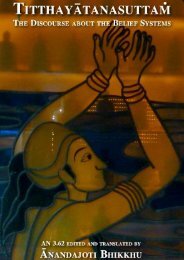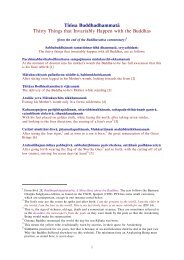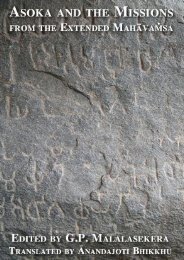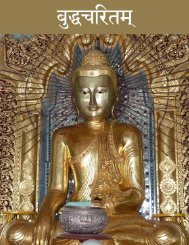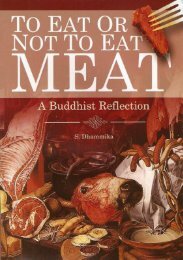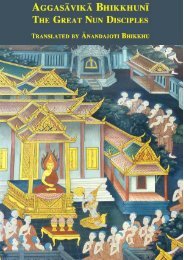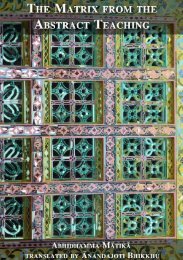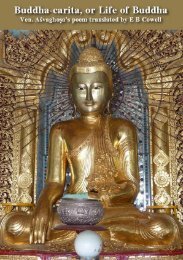MahÄkhandhako The Great Chapter - Ancient Buddhist Texts
MahÄkhandhako The Great Chapter - Ancient Buddhist Texts
MahÄkhandhako The Great Chapter - Ancient Buddhist Texts
You also want an ePaper? Increase the reach of your titles
YUMPU automatically turns print PDFs into web optimized ePapers that Google loves.
11<br />
new to the teaching, that he doesn’t know much, but he recites a verse which was<br />
enough for Sāriputta to attain to the first stage of Sainthood (Sotāpatti). 17<br />
This Assaji is normally identified with the Assaji who was one of the group-of-five<br />
monks. I question this though, as Assaji characterises himself as one who was new to<br />
the teaching and not long gone forth. But the group-of-five Assaji was hardly new to<br />
the Sāsana, indeed he stands right at the source. He had also heard some of the most<br />
important teachings that the Buddha had given, and had attained full liberation.<br />
<strong>The</strong>re is also no record of any of the monks from the Bāṇārasī period following the<br />
Buddha over from Kāsī to Magadha. Assaji must have been a common name at the<br />
time and given the weight of the evidence I am inclined to believe that the Assaji<br />
Sāriputta met was not the same as the one in the group-of-five, but was as he<br />
characterised himself, one newly gone forth.<br />
In any case on the strength of this encounter Sāriputta does see the Deathless and<br />
tells his friend Moggallāna about it, and they both leave Sañjaya, together with<br />
another 250 of his followers, and join the Buddha and become his chief disciples.<br />
This causes something of an uproar around the capital as many of their finest young<br />
men are going-forth. But the Buddha teaches a verse to the monks that convinces his<br />
critics that he is teaching true Dhamma and the uproar dies down. It is at this point<br />
in the text that the narrative ends.<br />
Comparison with other <strong>Texts</strong><br />
In preparing this text and translation of the <strong>Great</strong> <strong>Chapter</strong> I have made a careful<br />
comparison with other records of the same events, both in the Canon and the<br />
commentaries, together with texts like the Mahāvastu and Lalitavistara, which belong<br />
to other sects, so as to compare and supplement the information given in the text<br />
itself.<br />
This has involved making a number of other translations that are parallel to this text,<br />
and which are now published elsewhere on the website, and which can be read in<br />
their own right as well as supplementary to the present work:<br />
Uruvilvāto Ṛṣipatanaṁ Gamanaṁ - <strong>The</strong> Journey from Uruvilvā to Ṛṣipatana<br />
(from Mahāvastu pp. 322-329)<br />
Dharmacakrapravartanasūtram - <strong>The</strong> Discourse that Set the Dharma-Wheel<br />
Rolling (from Lalitavistara)<br />
Utpadyananirudhyanasūtram - <strong>The</strong> Discourse on Arising and Ceasing (<strong>The</strong><br />
Fourth Discourse of the Buddha) (Mahāvastu pp. 443-9)<br />
17 This verse became very famous later and is found in inscriptions all over India and Asia.


